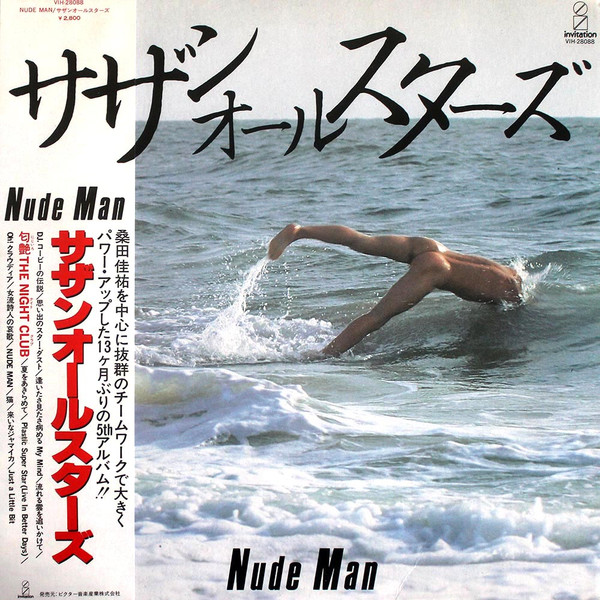It's no secret that Tatsuro Yamashita (山下達郎) is one of my favorite musicians of all time. However, the Japanese market didn't share that same sentiment back in the '70s. Prior to his breakthrough album, Ride On Time, Tatsuro had a rough time establishing himself as an artist. As a matter of fact, he was expected to retire after his 2nd album, Spacy didn't make its rejected sales. In 1978 he decided to release what everyone thought was going to be his last & final album, Go Ahead! Much in the same vein as Mariya Takeuchi's (竹内まりや) Variety, Go Ahead! was essentially a showcase album with each song representing all of Tatsuro's musical influences.
THE HISTORY
Based on the live atmosphere recorded in the previous work, It’s A Poppin’ TIme!, and his session work with other big names in the ‘70s such as Chu Kosaka ( 小坂忠 ) and Yumi Arai (荒井由実), the musical evaluation of Tatsuro Yamashita as an artist was favorable, however as a contract musician for a record company, Yamashita wasn’t meeting the sales figures RCA wanted. He was quite panicked himself and testifies that he was still learning about the production and distribution of commercial music during this period, and when he found out that record companies don’t respond well to a lack of improvement in sales, he felt he must finish his career as a solo musician.
All of the music was composed & arranged by Yamashita while receiving lyrical help once again by jazz & funk singer Minako Yoshida(吉田美奈子). The album was directed by Ryuzo "Jr." Kosugi (小暮徹), who participates in the chorus and percussion performances. Go Ahead! was released on December 20, 1978. His fortunes began to turn that year, when the A-side single, entitled Let’s Dance Baby became a smash hit in the Osaka disco scene. RCA re-labeled the single, swapping the sides to promote “Bomber” further. Tatsuro Yamashita’s newfound success in the disco market would influence his production on his next album in 1979, Moonglow.
THE MUSIC
A-SIDE
- Overture: A short & sweet soulful A Capella Intro, which leads into...
- Love Celebration: A very chill but funky Chicago-style R&B number. It’s also the only song on the album that Yamashita wrote & sang completely in English. He originally composed the song for future Dynasty member, Linda Carriere, for her album produced by Harry Hosono (細野 晴臣). But the project was scrapped and only a demo version exists. Later on, a different rendition was sung by Kimiko Kasai (笠井紀美子) and given Japanese lyrics, entitled Vibration.
- Let's Dance Baby: A super catchy Disco number with some Samba rhythms mixed in. Originally composed for the doo-wop group, The Kingtones, Yamashita's version doubles down on the Latin beat with some great backing vocals by Minako and Kosugi. The lyrics were written by Osamu Yoshioka(吉岡治). This song was Tats’ first single as a solo singer and ranked No. 75 On the Oricon charts.
- Monday Blue: A sorrowful ballad about losing a lover over the weekend, although towards the end of the song, the lyrics suggest some hope of revival. This song is the longest track on the album. The team behind this album consists of drummer Hidekazu 'Ponta' Murakami(村上 “ポンタ” 秀一), keyboardist Hiroshi Sato (佐藤博), guitarist Tsunehide Matsuki(松木恒秀)and bassist Akira Okazawa(岡沢章). Apparently, during production, nobody except Tats was confident about how this song would come out, but thankfully the control room staff during the recording had their breath taken away near the end of the song.
- ついておいで (Follow Me Along): Tatsuro starts us off with some jazzy crooning backed by a piano solo, and then takes us on a journey with a very optimistic 16-beat dance number.
B-SIDE
- Bomber: The highlight of the album, a rocking disco song that pays tribute to the Isley Bros. hard funk sound. Featuring the baddest bass-line in Tats' entire library of music, thanks to bassist Akihiro Tanaka(田中章宏). The song also has one of the best guitar solos only to be matched by Silent Screamer in 1980, both done by Kazuo Shiina (椎名 和夫). It also features some of the most unique lyrics in Japanese music as it tells the story of a man's bad altercation with the police. With English words/phrases like “Police”, “Judge Right”, “Target” and “Roulette”, one might wonder if Bombers lyrics might be alluding to some form of police/civil corruption in Japan in the '70s, or if it's just a tail of a sneaky crook trying to outwit the police.
- 潮騒 (The Whispering Sea): A summer love ballad inspired by the works of Todd Rundgren.
- Paper Doll: A funky style R&B number about taking love for granted, much in the same vein as Mariya's Plastic Love. Yamashita had recorded Paper Doll several months previously to be released as a single, but the record company didn’t have faith it would sell and scrapped the idea.
- This Could Be The Night: A cover of The Modern Folk Quartet’s 1965 hit single. It’s a pretty faithful remake with updated production value given a larger emphasis on Phil Spector's signature “Wall of Sound”.
- 2000トンの雨 (2000t Of Rain): A smooth resort pop finale that's another homage to the sound of Phil Spector, with its mix of Latin percussion and contemporary R&B elements, like the awesome saxophone.
THE VERDICT
Go Ahead! It is easily in my top 5 favorite Tatsuro Yamashita albums, with its Southern Soul-influenced tunes and funky bass lines. Tatsuro cast a pretty wide net of styles and nails them all perfectly, from the Todd Rundgren-Esque ballads in Shiosai to Chicago R&B reminiscent of Curtis Mayfield in Paper Doll, an homage to Phil Spector in 2000 Tons of Rain.
My personal favorite is the Isley Brothers-inspired Bomber. In my honest opinion, Bomber has got to be one of the greatest songs Tatsuro has ever produced, period. There are just so many layers to why the song stands out compared to other J-pop songs during and even after its time, from the choice of lyrics to Tats’ particular Americanized style of singing to the kick-ass bass-line. The bomber is a song that only Tatsuro himself can pull off flawlessly. Trust me I’ve heard a number of covers of this song and none of them come close in a million years, even the legendary male pop idol, Hideki Saijo couldn't do it justice.
My least favorite song is easily the cover song, This Could Be the Night. Tatsuro does great covers of songs, but I think his original content highlights his vocal range a lot better, there also wasn’t anything spectacular about the arrangements either. Despite that though I’ll definitely listen to Tatsuro’s version over the original any day. Overall I would definitely call this album an essential listen for all City Pop music fanatics.
 |
| Here's a shoutout to @slowestofsins for this awesome Tatsuro Yamashita fanart! Make sure to follow him on Instagram! |








No comments:
Post a Comment